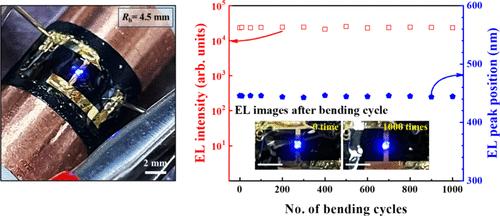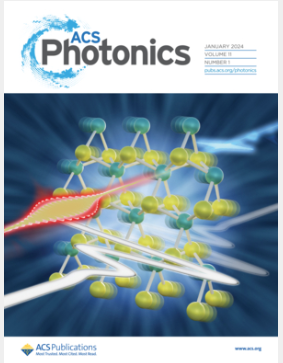Integration of InGaN/GaN Microrod Light Emitting Diodes on Flexible and Peelable Substrate via Dielectrophoretic Alignments
IF 6.5
1区 物理与天体物理
Q1 MATERIALS SCIENCE, MULTIDISCIPLINARY
引用次数: 0
Abstract
Flexible GaN-based microlight emitting diodes (μ-LEDs) are making a significant impact in emerging wearable technology due to their excellent performance, characterized by smaller size, fast response, low power consumption, and high luminance. However, most recent studies have focused on the separation and alignment of individual μ-LEDs on rigid substrates, rather than on flexible substrates. This study reports on the fabrication, separation, and horizontal alignment of rod-shaped InGaN/GaN μ-LEDs onto an interdigitated pattern using the dielectrophoresis (DEP) technique on a flexible substrate. A low-surface-energy polytetrafluoroethylene layer is introduced beneath the flexible polyimide layer, enabling physical peel-off from the rigid substrate. A maximum alignment efficiency of 82.3% is achieved on the flexible substrate via conventional DEP with a sinusoidal electric field at 1 MHz. The fabricated flexible horizontally aligned μ-LED (FHAL) chip is transferred onto carbon/copper tape for investigating optical and electrical characteristics. The FHAL chip exhibits consistent brightness, current–voltage, and electroluminescence characteristics even under bending deformation states with a radius of curvature as small as 4.5 mm. The EL spectra of the FHAL chip show a lower full width at half-maximum of 23 nm when operated at 10 V, indicating superior color saturation compared to flexible ultrathin blue organic LEDs (50 nm). Furthermore, stable optoelectrical characteristics are observed even after repeated bending deformation tests up to 1000 times. This work demonstrates that the proposed flexible, small pixel size, and high brightness FHAL chip is pertinent for emerging next-generation wearable display technology.

InGaN/GaN微棒发光二极管在可剥离柔性衬底上的介电泳集成
柔性氮化镓微发光二极管(μ- led)因其体积小、响应快、功耗低、亮度高等优异性能,在新兴可穿戴技术中发挥着重要作用。然而,最近的大多数研究都集中在单个μ- led在刚性衬底上的分离和排列上,而不是在柔性衬底上。本研究报道了在柔性衬底上使用介电电泳(DEP)技术在交叉模式上制造、分离和水平对齐棒状InGaN/GaN μ- led。在柔性聚酰亚胺层下面引入低表面能聚四氟乙烯层,使刚性基板能够物理剥离。在1 MHz的正弦电场下,通过传统的DEP在柔性衬底上实现了82.3%的最大对准效率。制备的柔性水平排列μ-LED (FHAL)芯片被转移到碳/铜带上,用于研究光学和电学特性。该FHAL芯片即使在曲率半径小至4.5 mm的弯曲变形状态下也具有一致的亮度、电流电压和电致发光特性。当工作电压为10 V时,FHAL芯片的EL光谱显示出较低的全宽,半宽为23 nm,与柔性超薄蓝色有机led (50 nm)相比,显示出更高的色彩饱和度。此外,即使经过多达1000次的反复弯曲变形测试,也可以观察到稳定的光电特性。这项工作表明,所提出的柔性、小像素尺寸和高亮度FHAL芯片与新兴的下一代可穿戴显示技术相关。
本文章由计算机程序翻译,如有差异,请以英文原文为准。
求助全文
约1分钟内获得全文
求助全文
来源期刊

ACS Photonics
NANOSCIENCE & NANOTECHNOLOGY-MATERIALS SCIENCE, MULTIDISCIPLINARY
CiteScore
11.90
自引率
5.70%
发文量
438
审稿时长
2.3 months
期刊介绍:
Published as soon as accepted and summarized in monthly issues, ACS Photonics will publish Research Articles, Letters, Perspectives, and Reviews, to encompass the full scope of published research in this field.
 求助内容:
求助内容: 应助结果提醒方式:
应助结果提醒方式:


